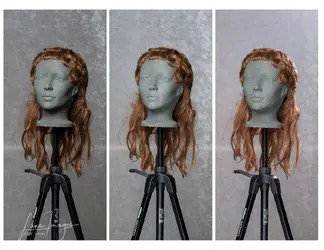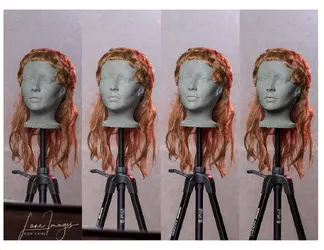ronlane
What's next?
- Joined
- Aug 3, 2012
- Messages
- 10,224
- Reaction score
- 4,961
- Location
- Mustang Oklahoma
- Can others edit my Photos
- Photos OK to edit
Thought I'd start this over in lighting and hardware.
I've been really putting in some time working on lighting in a studio environment. Having built a background stand out of PVC pipe and using a velour backdrop, I have been working on 2 and 3 light set-ups. The key is camera left with a 38" octabox, the fill is either a speedlight in a 2 foot softbox or a reflector and a studio strobe with a snoot for a hair light. I have shared some selfies with this set-up but I thought I would start this thread to help get some feed back and for others that are starting on this path.
I will start this thread with some photos of a styrofoam head and wig as my "new model" to spare @tirediron from having to see that "old broken down" model that I was using. (Also lets me work a little faster.)
1. Here is the lighting set-up as I built it up. The first image is the Streaklight 360 with a 38" octabox set up in a clamshell type lightest up about 4 feet. It was metered with a Sekonic L-308 to 1/200, ISO 200 at f/5.6. The second is adding a silver reflector set up underneath the key light. And the third adds a hair light that is also metered at 1/200, ISO 200 at f/5.6

2. This second set up images is using the above set-up with the silver reflector but added a gel to the hair light. The first is metered at f/5.6. The second is turned up to about f/8.0. The third is a blue gel going back to f/5.6.

3. These four images are all with the same metering with the red gel but this time I used the white side of the reflector. The difference is the location of the reflector. As you can see in the images, I moved it up and down. The final image of this set is with no reflector at all.

My thought is that I like the white reflector on the third image best because of the lighting ratio.
For those of you that are experienced, do I seem to be on the right track with these images? If not, what suggestions do you have?
Oh I did forget to mention that post processing is in LR only. I set the WB to the same on all of the images and I did auto in the basic panel and then zeroed out the exposure for all images.
I've been really putting in some time working on lighting in a studio environment. Having built a background stand out of PVC pipe and using a velour backdrop, I have been working on 2 and 3 light set-ups. The key is camera left with a 38" octabox, the fill is either a speedlight in a 2 foot softbox or a reflector and a studio strobe with a snoot for a hair light. I have shared some selfies with this set-up but I thought I would start this thread to help get some feed back and for others that are starting on this path.
I will start this thread with some photos of a styrofoam head and wig as my "new model" to spare @tirediron from having to see that "old broken down" model that I was using. (Also lets me work a little faster.)
1. Here is the lighting set-up as I built it up. The first image is the Streaklight 360 with a 38" octabox set up in a clamshell type lightest up about 4 feet. It was metered with a Sekonic L-308 to 1/200, ISO 200 at f/5.6. The second is adding a silver reflector set up underneath the key light. And the third adds a hair light that is also metered at 1/200, ISO 200 at f/5.6

2. This second set up images is using the above set-up with the silver reflector but added a gel to the hair light. The first is metered at f/5.6. The second is turned up to about f/8.0. The third is a blue gel going back to f/5.6.

3. These four images are all with the same metering with the red gel but this time I used the white side of the reflector. The difference is the location of the reflector. As you can see in the images, I moved it up and down. The final image of this set is with no reflector at all.

My thought is that I like the white reflector on the third image best because of the lighting ratio.
For those of you that are experienced, do I seem to be on the right track with these images? If not, what suggestions do you have?
Oh I did forget to mention that post processing is in LR only. I set the WB to the same on all of the images and I did auto in the basic panel and then zeroed out the exposure for all images.


![[No title]](/data/xfmg/thumbnail/33/33440-0778f3522902634844facab43c5a29fa.jpg?1734163468)










![[No title]](/data/xfmg/thumbnail/32/32926-ec27ecead8c80d803404500d8f888dbf.jpg?1734162683)